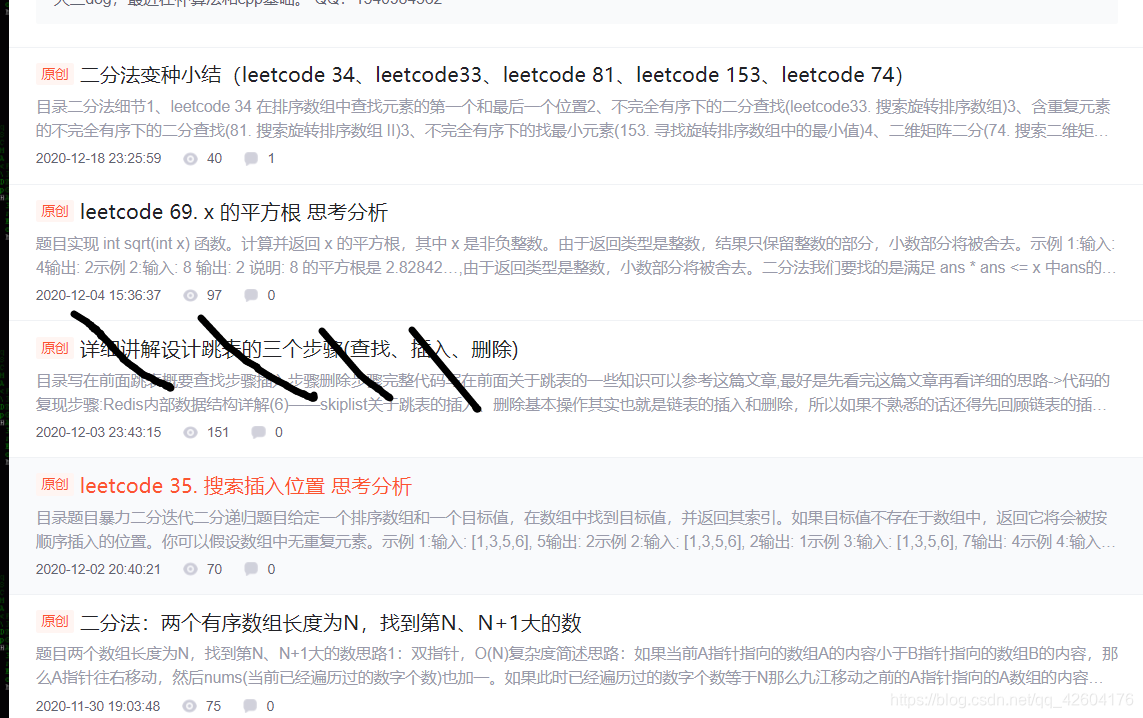目錄
- 1、快速排序復習
- 2、鏈表部分復習
- 203. 移除鏈表元素
- 707. 設計鏈表
- 206. 反轉鏈表
- 142.環形鏈表 II
- 3、二分法復習
- 4、哈希法復習
- 5、雙指針復習
- **15. 三數之和**
- **18. 四數之和**
- **27. 移除元素**
- **344. 反轉字符串**,簡單,雙指針從兩側往中間靠攏,并隨時swap
- **劍指 Offer 05. 替換空格**
- **151. 翻轉字符串里的單詞**
1、快速排序復習
基本思想:
1、在當前的排序序列中任意選取一個元素,把該元素稱為基準元素或支點,把下雨等于基準元素的所有元素都移動到基準元素的前面,把大于基準元素的所有元素都移到基準元素的后面,這樣使得基準元素所處的位置 恰好就是排序的最終位置,并且把當前參加排序的序列分為前后兩個序列。
2、上述的過程稱為一趟快速排序,即快速排序的一次劃分
3、接下來分別對這兩個子序列重復上述的排序操作(如果子序列長度大于1的話),直到所有元素都被移動到排序后他們應處的最終位置上。
效率之所以高:每一次元素的移動都是跳躍的,不會像冒泡排序只能在相鄰元素之間進行,元素移動的間隔較大,因此總的比較和移動次數減少
具體步驟:
1、假設序列a,設置兩個變量i、j.分別指向首元素和尾元素,設定i指向的首元素為基準元素
2、反復執行i++,直到i指向的元素>=基準元素,或者i指向尾部
3、反復執行j–,直到指向的元素<基準元素,或者j指向頭部
4、若此時i<j,將i和j指向的元素進行交換。(大的元素在后面)
5、完成第一次交換后,重復執行步驟1、2,直到i>=j位置
6、此時i>=j,然后將基準元素與j指向的元素交換位置,至此完成了原序列的第一次劃分
7、接下來分別對基準元素前后的子序列中長度大于1的子序列重復執行上述操作。
步驟分析:
對于每個子序列的操作又是一次劃分,因此這個算法具有遞歸性質。
每次劃分過程的基準元素仍可設定為子序列的第一個元素
#include<iostream>
#include <vector>
using namespace std;
//快速排序
void Quicksort(vector<int>& a, int s, int t)
{int i, j;if (s < t){//【1】設置兩個變量i、j.分別指向首元素和尾元素,設定i指向的首元素為基準元素i = s;j = t + 1;while (1){do i++;while (!(a[s] <= a[i] || i == t)); //【2】重復i++操作,直到i指向的元素>=基準元素,或者i指向尾部do j--;while (!(a[s] >= a[j] || j == s)); //【3】反復執行j--,直到指向的元素<基準元素,或者j指向頭部if (i < j) //【5】若此時i<j,將i和j指向的元素進行交換。(大的元素在后面){swap(a[j], a[i]);}else break; //【5】完成第一次交換后,重復執行步驟1、2,直到i>=j位置}//【6】此時i>=j,然后將基準元素與j指向的元素交換位置,至此完成了原序列的第一次劃分swap(a[s], a[j]);//【7】接下來分別對基準元素前后的子序列中長度大于1的子序列重復執行上述操作。Quicksort(a, s, j - 1); //前半序列Quicksort(a, j + 1, t); //后半序列}
}
void show_sort_result(vector<int> a, int k)
{for (int f = 0;f < k;f++){cout << a[f] << " ";}printf("\n");
}
int main()
{vector<int> a = { 98,76,109,34,67,190,80,12,14,89,1 };printf("快速排序\n");Quicksort(a,0,a.size() - 1);show_sort_result(a, a.size() - 1);return 0;
}
2、鏈表部分復習
鏈表定義
struct ListNode {int val;ListNode *next;ListNode() : val(0), next(nullptr) {}ListNode(int x) : val(x), next(nullptr) {}ListNode(int x, ListNode *next) : val(x), next(next) {}
};
203. 移除鏈表元素
不使用虛擬頭節點
class Solution {public:ListNode* removeElements(ListNode* head, int val) {//刪除頭節點while(head != nullptr && head->val == val){ListNode* temp = head;head = head->next;delete(temp);}//刪除非頭節點ListNode* cur = head;while(cur != nullptr && cur->next != nullptr){if(cur->next->val == val){ListNode* temp = cur->next;cur->next = cur->next->next;delete(temp);}else {cur = cur->next;}}return head;}
};
使用虛擬頭節點:
注意如果使用指針的話,沒有delete dummy會造成內存泄漏。
class Solution {public:ListNode* removeElements(ListNode* head, int val) {ListNode* dummyHead = new ListNode(0);dummyHead->next = head;ListNode* cur = dummyHead;while(cur->next != nullptr){if(cur->next->val == val){ListNode* temp = cur->next;cur->next = cur->next->next;delete temp;}else {cur = cur->next;}}ListNode* ret = dummyHead->next;delete dummyHead;return ret;}
};
707. 設計鏈表
注意虛擬頭節點的使用。
class MyLinkedList {
public://定義鏈表的結構體struct ListNode {int val;ListNode* next;ListNode(int val) : val(val) , next(nullptr) {}};
private://定義鏈表的虛擬頭節點ListNode* _dummyHead;int _size;
public:/** Initialize your data structure here. */MyLinkedList() {_dummyHead = new ListNode(0);_size = 0; //記錄鏈表中已經存在的元素個數}/** Get the value of the index-th node in the linked list. If the index is invalid, return -1. */int get(int index) {if(index < 0 || index > _size -1)return -1;ListNode* cur = _dummyHead->next;while(index--){cur = cur->next;}return (cur->val);}/** Add a node of value val before the first element of the linked list. After the insertion, the new node will be the first node of the linked list. */void addAtHead(int val) {ListNode* newNode = new ListNode(val);newNode->next = _dummyHead->next;_dummyHead->next = newNode;_size++;}/** Append a node of value val to the last element of the linked list. */void addAtTail(int val) {ListNode* newNode = new ListNode(val);ListNode* cur = _dummyHead; //注意cur從_dummy開始,防止鏈表一開始為空while(cur->next != nullptr){cur = cur->next;}//此時cur->next為空cur->next = newNode;_size++;}/** Add a node of value val before the index-th node in the linked list. If index equals to the length of linked list, the node will be appended to the end of linked list. If index is greater than the length, the node will not be inserted. */void addAtIndex(int index, int val) {if(index > _size) return ;if(index < 0){addAtHead(val);return ;} ListNode* newNode = new ListNode(val);ListNode* cur = _dummyHead;while(index--){cur = cur->next;}newNode->next = cur->next;cur->next = newNode;_size++;}/** Delete the index-th node in the linked list, if the index is valid. */void deleteAtIndex(int index) {if(index >= _size || index < 0){return ;}ListNode* cur = _dummyHead;while(index--)cur = cur->next;ListNode* temp = cur->next;cur->next = cur->next->next;delete temp;_size--;}
};/*** Your MyLinkedList object will be instantiated and called as such:* MyLinkedList* obj = new MyLinkedList();* int param_1 = obj->get(index);* obj->addAtHead(val);* obj->addAtTail(val);* obj->addAtIndex(index,val);* obj->deleteAtIndex(index);*/
206. 反轉鏈表
注意while循環的條件以及最后返回的是pre。
class Solution {
public:ListNode* reverseList(ListNode* head) {ListNode* cur = head;ListNode* pre = nullptr;while(cur != nullptr){ListNode* temp = cur->next;cur->next = pre;pre = cur;cur = temp;}return pre;}
};
142.環形鏈表 II

數學推導:
相遇時:
slow走過節點數:x+y
fast走過節點數:x+y+n(y+z)
并且有:
(x+y)*2 = x+y+n(y+z)
當n= 1時,x = z:
即:
從頭節點出發一個指針,從相遇節點也出發一個指針,這兩個指針每次只走一個節點,那么當這兩個指針相遇的時候就是環形入口的節點了。
class Solution {
public:ListNode *detectCycle(ListNode *head) {ListNode* fast = head;ListNode* slow = head;while(fast != nullptr && fast->next != nullptr) {slow = slow->next;fast = fast->next->next;//快慢指針相遇if(fast == slow){ListNode* index1 = fast;ListNode* index2 = head;while(index1 != index2){index1 = index1->next;index2 = index2->next;}return index2;}}return nullptr;}
};
3、二分法復習
二分法變種對于不完全有序的還需要再刷刷

4、哈希法復習
242. 有效的字母異位詞
https://leetcode-cn.com/problems/valid-anagram/
349. 兩個數組的交集,注意set的使用,還是不太熟悉
https://leetcode-cn.com/problems/intersection-of-two-arrays/
202. 快樂數
https://leetcode-cn.com/problems/happy-number/
1. 兩數之和,注意map的使用,不是很熟悉,要熟悉map的insert操作
https://leetcode-cn.com/problems/two-sum/submissions/
454. 四數相加 II ,注意count加上的是該值上所有的頻次。
https://leetcode-cn.com/problems/4sum-ii/submissions/
383. 贖金信,注意在map中加哪個減哪個。如果ransomNote中出現了magazine不存在的字母,則失敗。
https://leetcode-cn.com/problems/ransom-note/
5、雙指針復習
15. 三數之和
https://leetcode-cn.com/problems/3sum/
需要注意三個地方:
1、第一次去重,在外層for循環中,如果遇到相同的相鄰元素continue
2、第二次去重,每一次找到一次三元組后也要進行一次去重,直到不再符合left < right
3、找到一個答案后,雙指針同時收縮
class Solution {
public:vector<vector<int>> threeSum(vector<int>& nums) {sort(nums.begin(),nums.end());vector<vector<int>> result;for(int i = 0; i < nums.size(); i++){if(nums[i] > 0) break;//第一次去重,在外層for循環中,如果遇到相同的相鄰元素continueif(i > 0 && nums[i] == nums[i-1]) continue;int left = i + 1;int right = nums.size() - 1;while(left < right) //不能取={int tmp_sum = nums[i] + nums[left] + nums[right];if(tmp_sum > 0) right--;else if(tmp_sum < 0) left++;else {result.emplace_back(vector<int>{nums[i],nums[left],nums[right]});//第二次去重,每一次找到一次三元組后也要進行一次去重,直到不再符合left < rightwhile(left < right && nums[right - 1] == nums[right]) right--;while(left < right && nums[left] == nums[left + 1]) left++;//找到一個答案后,雙指針同時收縮left++;right--;}}}return result;}
};
18. 四數之和
https://leetcode-cn.com/problems/4sum/
需要注意地方:
分為3重嵌套,比上一題多了一層循環。所以在最外層也多一個去重。
剪枝操作時錯誤的,不可以剪枝。
三數之和:
for{
剪枝;
去重;
while(再去重);
}
四數之和:
for
{
去重;
for{去重;while(再去重);
}
}
27. 移除元素
https://leetcode-cn.com/problems/remove-element/
重點在于fast每時每刻都在往后走(無論該元素是否==val),如果不等于的話slow也需要走。nums【fast】=val的時候slow不走,fast走。
接著到下一個 nums【fast】!=val時,將指向的元素向前移動。
class Solution {
public:int removeElement(vector<int>& nums, int val) {int slow = 0;for(int fast = 0; fast < nums.size(); fast++){if(nums[fast] != val){nums[slow] = nums[fast];slow++;}}return slow;}
};
344. 反轉字符串,簡單,雙指針從兩側往中間靠攏,并隨時swap
https://leetcode-cn.com/problems/reverse-string/
劍指 Offer 05. 替換空格
先計算擴充后大小,然后從后向前替換空格。數組填充類題均是這樣做。
https://leetcode-cn.com/problems/ti-huan-kong-ge-lcof/
class Solution {
public:string replaceSpace(string s) {int count = 0; //記錄空格數int old_size = s.size();for(int i = 0; i < old_size; i++){if(s[i] == ' ') count++;}//擴充ss.resize(old_size + count * 2);int new_size = s.size();//定義兩個指針,指向兩個位置int new_index = new_size - 1;int old_index = old_size - 1;while(old_index < new_index) {if(s[old_index] != ' '){s[new_index] = s[old_index];} else{s[new_index] = '0';new_index--;s[new_index] = '2';new_index--;s[new_index] = '%';}new_index--;old_index--;}return s;}
};
151. 翻轉字符串里的單詞
,這一題還得多做幾遍。。
https://leetcode-cn.com/problems/reverse-words-in-a-string/
這一題對空格的處理操作更加繁瑣一點;
思路:
1、移除多余空格
2、將整個字符串反轉
3、將每個單詞反轉
如:
“the sky is blue” => “the sky is blue” => “eulb si yks eht” => “blue is sky the”
1、去除多余空格,使用雙指針
void removeExtraSpaces(string& s){//定義快慢指針int slow = 0;int fast = 0;//去除字符串前面的空格while(s.size() > 0 && fast < s.size() && s[fast] == ' ') fast++;//去除字符串中間的榮譽空格while(fast < s.size()){if(fast > 1 && s[fast] == ' ' && s[fast - 1] == ' ') {fast++;continue;}else{s[slow] = s[fast];slow++;fast++;}}//去除字符串末尾的空格,并重新設置字符串大小if(slow > 1 && s[slow - 1] == ' '){s.resize(slow - 1);}else{s.resize(slow);}}
2、反轉字符串,使用雙指針
void reverse(string& s,int left,int right) {while(left <= right){swap(s[left],s[right]);left++;right--;}}
3、將字符串中的每個單詞反轉
string reverseWords(string s) {removeExtraSpaces(s);reverse(s,0,s.size() - 1);int fast = 0; int slow = 0;while(fast < s.size()){//如果遍歷到字符串中間一個單詞結束if(s[fast] == ' '){reverse(s,slow,fast - 1);//跳過空格slow = fast + 1;}//如果遍歷到最后一個單詞結束(此時沒有空格)if(fast == s.size() -1){reverse(s,slow,fast);}fast++;}return s;}
—— 規劃集群部署)

)
)






)

)






